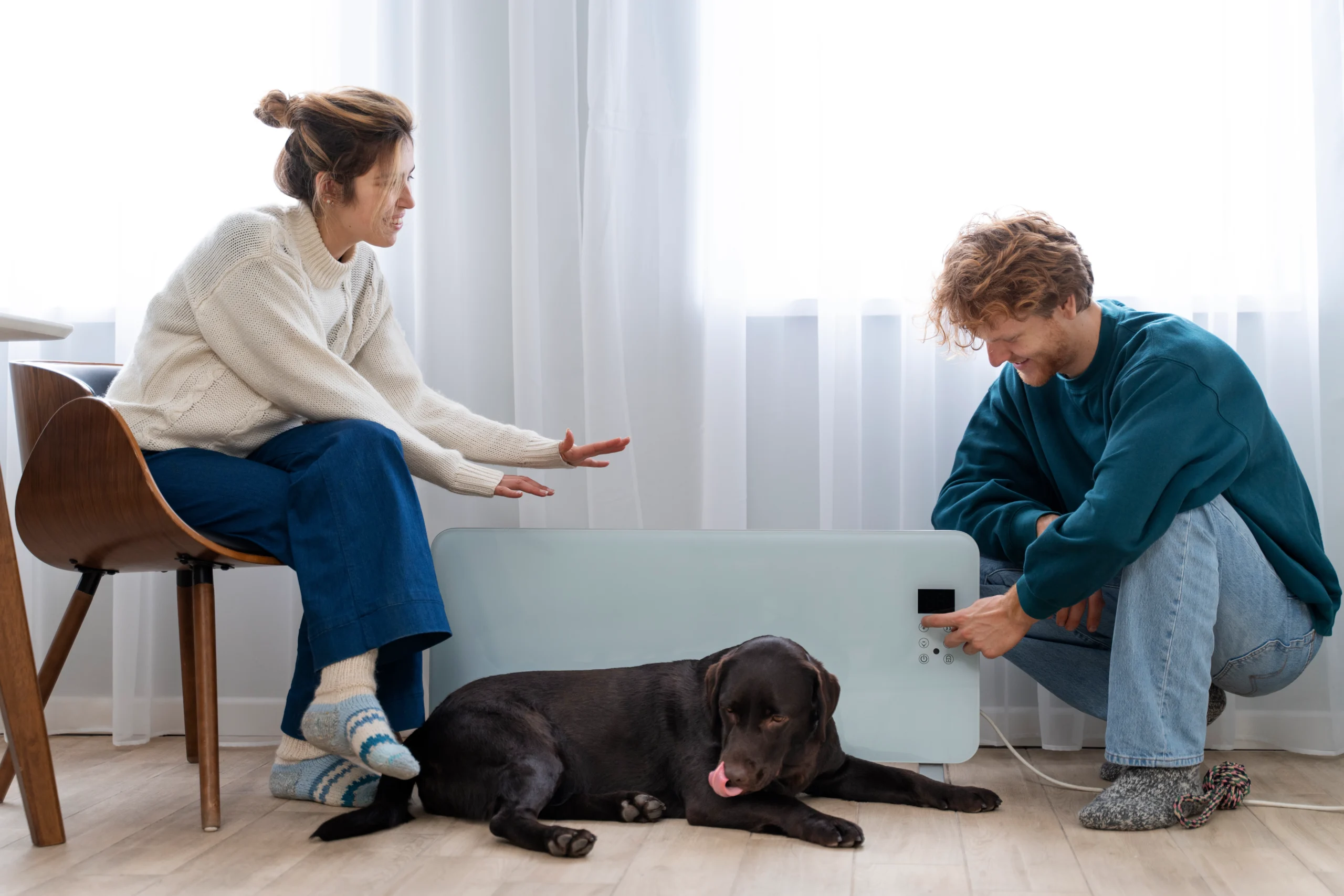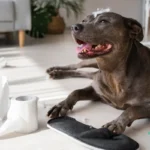Keeping your dog clean and comfortable is very important. But, going outside to pee can be hard, especially in cities or when you can’t go outside. A dog litter box is a great way to let your dog go to the bathroom inside. It makes your life easier and keeps your dog happy.
If you live in a busy city, deal with bad weather, or have a senior or disabled dog, indoor potty systems are a big help. They meet your dog’s needs and make your life easier. Learn how to use a dog litter box and train your dog for indoor potty breaks.
Key Takeaways
- Dog litter boxes provide a convenient indoor potty solution for urban, weather-challenged, or senior/disabled pet owners.
- These systems offer flexibility and control in your dog’s bathroom routine, reducing the hassle of outdoor excursions.
- Proper training and setup are key to successfully incorporating an indoor dog potty into your home.
- Explore various litter box options, from traditional trays to dog grass pads, to find the best fit for your space and pet’s needs.
- Maintaining the indoor potty system with regular cleaning and supplies is essential for your dog’s hygiene and your home’s cleanliness.
Understanding the Need for Indoor Dog Potty Solutions
As pet owners, we want the best for our dogs. For those in cities or with little outdoor space, an indoor dog toilet is key. These solutions meet our pets’ needs, offering a handy indoor option instead of outdoor potty breaks.
Benefits for Urban Pet Parents
City living or apartment life can make it hard to give dogs enough outdoor time. An indoor dog potty tray helps, letting dogs go without needing to go outside often. It saves time and keeps them safe and sound.
Weather-Related Advantages
Bad weather like rain, snow, or heat makes outdoor potty breaks tough. A litter box for dogs is a smart fix, letting dogs go indoors. It keeps them comfy and safe from harsh weather.
Convenience for Senior and Disabled Dogs
Older or disabled dogs find going outside hard. An indoor dog toilet makes things easier, keeping them independent and dignified. It means no long outdoor trips, helping them stay well cared for.
Indoor dog potty solutions are a great choice for many pet owners. They’re useful for city folks, those facing bad weather, or those with senior or disabled dogs. These products make life easier and better for both pets and their owners.
Types of Dog Litter Box Systems Available
The market offers many dog litter box systems for indoor relief. You can find everything from traditional litter boxes to grass pad designs. These options cater to your dog’s size, preferences, and your home’s needs.
Traditional Litter Boxes
The classic dog litter box looks like a cat litter tray. It’s made of durable plastic and uses dog litter or fake grass for dogs. This setup is familiar and easy for your dog to use.
Grass Pad Systems
Dog litter pan systems with artificial grass are a natural choice. They have a tray and a grass pad that’s easy to clean and replace. These dog proof litter box designs are great for city living and small spaces.
Innovative Designs
New designs in dog litter boxes meet different needs. You can find self-cleaning models and enclosed units that control odors. These advanced systems offer more convenience and function.
| Feature | Traditional Litter Box | Grass Pad System | Innovative Designs |
|---|---|---|---|
| Material | Plastic | Artificial Grass, Plastic Tray | Varies (e.g., Plastic, Stainless Steel) |
| Cleaning | Scoop Litter | Replace Grass Pad | Self-Cleaning or Easy Maintenance |
| Odor Control | Depends on Litter Type | Contained in Tray Design | Advanced Odor Filtration Systems |
| Dog Size Suitability | Varies by Box Size | Suitable for Most Dog Sizes | Designed for Specific Dog Sizes |
Understanding the many options helps pet owners choose the right dog litter pan or dog proof litter box. This choice should meet your dog’s needs and your preferences.
Choosing the Right Indoor Dog Toilet for Your Space
When picking an indoor dog potty, think about your home’s size and your dog’s needs. Your dog’s size, how active they are, and your cleaning habits matter. These factors help pick the best dog litter box or indoor dog potty for your home.
Size Considerations
Measure your floor space and pick a dog grass pad or indoor dog potty that fits well. A potty that’s too small might cause accidents. A too-large one might take up too much room. Make sure it’s big enough for your dog.
Material Options
Dog litter boxes are made from different materials, each with its own benefits. Plastic and metal dog litter boxes are tough and simple to clean. Wooden or wicker ones can make your space look nicer. Dog grass pads and absorbent pads give a more natural feel for your dog.
Maintenance Requirements
Think about how often you’ll need to clean different indoor dog potty systems. Some need more scooping or pad changes than others. Choose one that fits your cleaning schedule for an easy experience.
By considering these points, you can find the ideal indoor dog toilet. It will meet your dog’s needs and fit well in your home.
Dog Grass Pad vs Traditional Litter Boxes
Choosing an indoor potty for your dog comes down to two main options: fake grass for dogs or dog litter pan systems. Each has its own benefits and things to think about. These can match your dog’s needs and your home’s setup.
A dog grass pad looks like real grass, making it a cozy spot for your dog. It’s also easy to keep clean because urine drains into a tray. This makes it a great choice for dogs who love the grass feel.
| Feature | Dog Grass Pad | Traditional Litter Box |
|---|---|---|
| Appearance | Natural, grass-like | Utilitarian, less visually appealing |
| Odor Control | May be more effective with proper drainage | Requires regular cleaning and litter changes |
| Ease of Cleaning | Typically more convenient | May require more hands-on cleaning |
| Cost | Generally more expensive upfront | Often more budget-friendly |
When picking between fake grass for dogs and a dog litter pan, think about your dog’s size and your home’s space. Also, consider what you prefer. The best indoor dog toilet depends on your specific needs and your dog’s.
Setting Up Your Dog Litter Box for Success
Starting a successful indoor dog potty solution begins with the right setup of your dog potty tray or litter box for dogs. Choose the perfect location and create a welcoming space. These steps are key to helping your dog adjust to their new dog proof litter box.
Location Selection
Find a quiet, low-traffic spot in your home for your dog’s litter box. Stay away from busy areas that might distract or stress them. Also, put the box near where your dog usually goes to the bathroom. This helps them follow their natural habits.
Creating a Comfortable Environment
Make the area around the litter box inviting. Use a soft, non-slip surface like a rubber mat or low-pile carpet. Let your dog explore and get used to the new setup slowly. Positive feedback, like treats or praise, can help them feel good about it.
Essential Supplies Needed
- High-quality, absorbent dog litter
- Litter box with tall sides to prevent spills
- Cleaning supplies (pooper scooper, trash bags, disinfectant)
- Rewards or treats to encourage use
By picking the right spot, making the area comfy, and having the right supplies, you’re on the path to successful indoor dog potty training.
Step-by-Step Training Methods for Dog Potty Tray Use
Teaching your dog to use an indoor dog potty or dog litter box is a big help for city dwellers or those facing bad weather. A positive, step-by-step method can make your dog use their dog grass pad or litter tray without trouble. Here’s how to start your dog on the right path.
- Establish a Routine: Being consistent is crucial for training your dog. Pick a spot for the dog litter box and take your dog there often. This could be after meals, naps, or playtime.
- Positive Reinforcement: Give treats, praise, and affection when your dog uses the indoor dog potty area. This positive feedback will help them keep using the right spot.
- Patience and Perseverance: Training your dog takes time and patience. Stay calm and keep up the good work, even when there are setbacks.
- Supervision and Redirection: Watch your dog closely during training. If they need to go, guide them to the dog grass pad. Reward them for using the right spot.
By using these steps, you can train your dog to use their dog litter box successfully. Remember, every dog learns at their own pace. Be patient, consistent, and celebrate the small wins.
“Patience and positive reinforcement are the keys to successful dog litter box training. With time and dedication, your pup will be a pro at using their indoor dog potty in no time.”
Common Challenges and Solutions in Litter Box Training
Introducing a dog litter pan or indoor dog toilet can change your life. But, it might face some hurdles. Let’s look at common problems and find ways to overcome them for a smooth transition.
Resistance to Using the Box
If your dog is slow to accept the dog litter pan, try these tips:
- Start by introducing the indoor dog toilet slowly. Make it a positive experience with treats or play.
- Put the dog potty tray in a quiet spot. Make sure it’s clean and welcoming.
- Use a pheromone product to help your dog feel more comfortable using the litter box.
Accuracy Problems
Accidents are normal, but with time, your dog will get better. Here’s how to improve accuracy:
- Take your dog to the dog litter pan more often. Do it after meals, naps, and play.
- Always praise and reward your dog when they use the indoor dog toilet right.
- Think about using a litter box with higher walls or a cover to catch any misses.
Maintenance Issues
Keeping the dog potty tray clean is key for your dog’s comfort and your sanity. Here’s how to keep up with cleaning:
| Task | Frequency |
|---|---|
| Scoop solid waste | Daily |
| Replace litter | Every 2-3 days |
| Thoroughly clean the box | Weekly |
By tackling these common issues and using the suggested solutions, you’ll have a successful dog litter pan training. Your furry friend will enjoy a clean and easy indoor relief experience.
Maintaining Your Indoor Dog Potty System
It’s important to keep your dog’s litter box clean and odor-free. Start by setting up a regular cleaning schedule. Empty and replace the litter or fake grass as needed. Use a mild, pet-safe cleaner to scrub the tray and remove any smells or bacteria.
Make sure to replace disposable parts like pads or liners as the manufacturer suggests. This keeps your system working well and keeps your dog healthy and happy.
Using products like baking soda or enzyme cleaners can also help. They can reduce smells and keep the area smelling fresh. With a little effort, you can keep your dog’s indoor potty area clean and welcoming.




